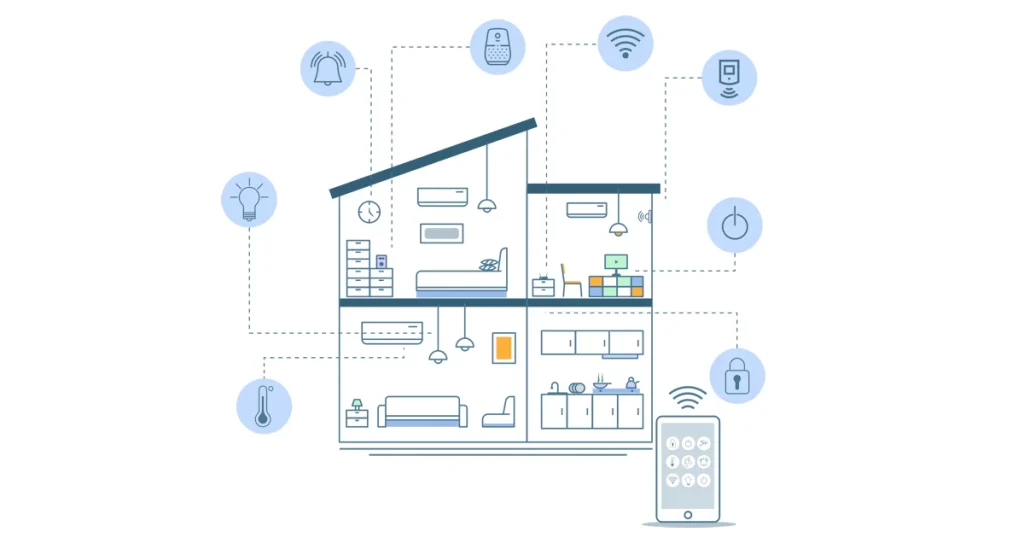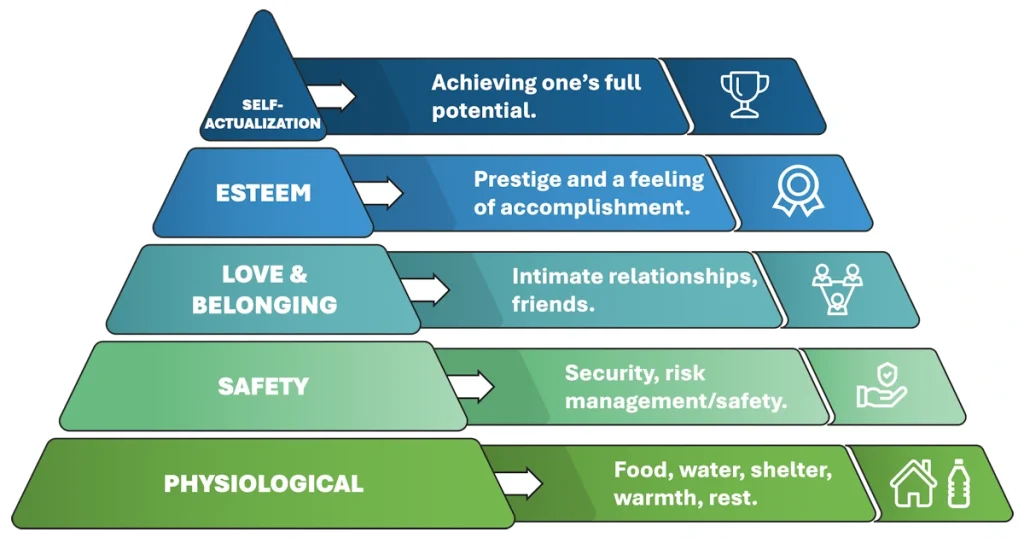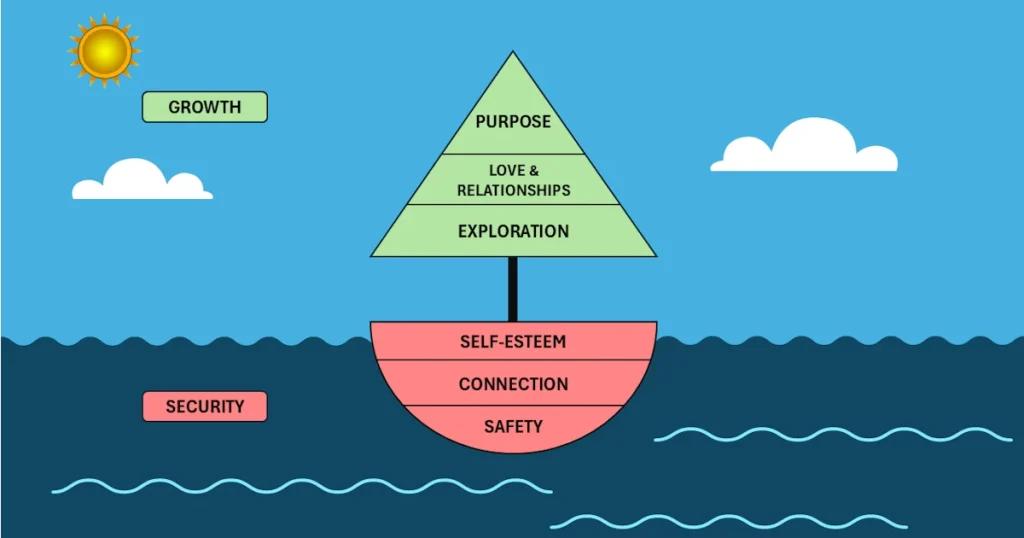Telecare is currently the most widely used and popular form of technology-enabled care (TEC) in the UK. It provides a risk management safety blanket via a reactive service model, relying on alarms that can be manually activated by pressing a button or automatically triggered by sensors, which are then received at a monitoring centre. This provides reassurance to individuals and their families, establishing a solid foundation for care technology services.
However, life involves more than simply feeling secure.
An individual has a spectrum of needs that extend beyond basic survival to include fulfilling their potential and living a meaningful life. This article explores how technology can address these needs across all areas, enabling individuals to lead more fulfilling lives.
The Status Quo
Approximately 1.8 million people in the UK use telecare, allowing them to automatically contact a monitoring service in an emergency or for reassurance. Telecare services in the UK are currently undergoing a significant transformation, driven by the modernisation of the country’s telecommunication networks, which are transitioning to an all-IP network and phasing out the use of copper landlines. As a result, services are making substantial investments to upgrade their legacy analogue telecare equipment to use and benefit from digital technologies.
This effort is generally regarded as a like-for-like upgrade, primarily aimed at maintaining the continuity of alarm-based telecare services, with some limited functional improvements but no significant feature enhancements for end-users.
Many see this digitisation of alarm-based telecare as a missed opportunity.
We All Live in a Digitally Connected World
Today’s predominantly reactive service model is partly a result of the technology available when social alarms were first developed. The consumer technology landscape has undergone significant changes since the introduction of telecare services. The copper landline revolution, which connected homes to the analogue telephone network (PSTN) in the late 20th century, has been replaced by ultrafast broadband using Fibre-To-The-Home (FTTH) and widespread 4G and 5G mobile connectivity. These technologies provide an ‘always-on’ connection, allowing people to stay connected wherever they are.
This has enabled further innovations, including smart home technologies and the Internet of Things (IoT), which use sensors and devices within homes and on individuals (wearables) to support smart, digitally connected applications and services, as shown in Figure 1.

Mainstream consumer products and applications are increasingly being used to support independent living, often providing solutions at a much lower cost than traditional specialist equipment. These modern digital technologies, which are widely used, help diminish or overcome the stigma associated with many dedicated or bespoke care technologies. They provide features that extend beyond alarms to include other practical applications for everyday needs, such as closed-loop responses to emerging issues, whether environmental, medical, or social.
Perhaps the most significant disruptor in the sector will be the smartphone, which is rapidly replacing mobile phones across all age groups. It not only offers a convenient way to stay in touch with family and friends but also unlocks the nearly limitless world of apps. This versatility, available through a single device, has the potential to transform how people can be supported in their day-to-day lives.
There’s More to Life than Alarms
For technology-enabled care to achieve positive outcomes and create a lasting impact, it must be user-centred and needs-led. High-quality evidence supporting the use of care technologies remains frustratingly limited. Nonetheless, it is widely accepted that the best outcomes occur when technology is well-matched and personalised to the needs and circumstances of the individual receiving support. These needs can be either straightforward or complex; in either case, they can be mapped onto Maslow’s hierarchy of needs, which consists of five levels of human motivations and needs, often depicted as a pyramid, shown in Figure 2.

According to Maslow, needs can be classified based on whether they are related to deficiencies or growth. Individuals often have multiple needs, usually across all levels of this hierarchy.
Deficiencies are located at the bottom four levels of the pyramid and are generally due to deprivation (e.g. a lack of food or shelter). Meeting these basic needs is essential for survival and for laying a secure foundation on which to build a life. If these needs aren’t met, the individual experiences anxiety, stress, or other negative emotions. They generally need to be satisfied first before focusing on growth needs. In care contexts, many individuals remain trapped in a state of deficiency, focusing on survival and stability, particularly when their basic needs are unmet.
Growth needs, located at the top of the pyramid, do not stem from a lack of something, but rather from a desire to grow as a person; they arise from a drive for fulfilment. Unlike deficiency needs, growth needs can never be fully ‘satisfied’; the more we grow, the more we want to grow. Pursuing these needs brings about positive emotions, such as joy, independence and a sense of purpose.
So, once people feel safe, connected, and respected, they can begin to reclaim their agency and aspirations; this is where growth happens.
The goal for us all is to achieve ‘self-actualisation’, which Maslow described as “to become more and more what one is, to become everything that one is capable of becoming.”
In other words, to live your best life.
Kauffman’s Sailboat Metaphor
A modern, alternative interpretation of Maslow’s hierarchy of needs, developed by psychologist Scott Barry Kaufman, is illustrated in Figure 3 below, where the hierarchy is represented as a sailboat.

The hull of the sailboat signifies three fundamental ‘security’ needs, which must be fulfilled to establish a solid foundation for building a meaningful and fulfilling life. Once these needs are met and the boat is ‘seaworthy’, we can ‘raise the sail’ and move toward personal growth and fulfilment.
The use of technology to help fulfil these needs is briefly discussed below.
Safety
This is the confidence that comes from knowing things will probably be alright, even during difficult times.
Potential uses of technology to aid safety include alarm-based telecare with 24/7 monitoring and response, fall detectors, environmental sensors (such as room temperature, smoke/heat, gas, CO2, flood, humidity, and ambient light), GPS wearables and navigation, smart home automation (e.g., automated lighting to illuminate the way to the bathroom at night), and proactive telecare that use predictive analytics and alerts to prevent issues from occurring in the first place.
Connection
This represents the need for belonging (and Wi-Fi and battery!).
Technology-enabled care services can assist with this by enabling easy access to installation services, monitoring services, and a response team. Beyond this, many consumer technologies are designed to facilitate communication, including phone calls, messaging (such as social media), sharing photos and videos, and video calls. Digital or virtual befriending services provide a safe platform for people to connect and form friendships remotely.
People living with dementia have been shown to benefit from digital reminiscence therapy that enables them to connect with their past and with memories that seem more recent to them. Family and caregiver dashboards enable passive check-ins without intrusion, allowing loved ones to feel part of their family member’s care.
Self-Esteem
This is all about feeling good about ourselves, and part of this involves feeling in control.
Technology plays a role in this process, including how it is selected, configured, and managed. For example, the ability to give informed consent and modify it, along with customisable alert preferences and privacy settings, empowers individuals to stay in control of how technology supports them.
Beyond such ethical considerations, technological applications can help individuals feel in control of their lives. Self-tracking apps enable people to monitor their own health conditions, activities, routines, and achievements. Individuals can respond to advice and alerts themselves and make changes accordingly without relying as heavily on healthcare services.
Digital care planning platforms increasingly support co-production and shared decision-making, allowing progress and achievements to be logged and shared. Wearable assistive technologies (e.g., hearing aids, mobility aids, or cognitive aids) enhance independence and are becoming less obtrusive, while also becoming more aesthetically pleasing. AI voice assistants offer an alternative way of interacting with technology, providing information and advice, as well as enabling smart home operation, which can help support independent living.
Exploration
This represents a sense of curiosity, adventure, and open-mindedness.
Again, TEC can play a role here. Apps and data dashboards display monitored health, activity, and wellbeing trends, encouraging curiosity about one’s health. Digital connectivity enables online learning or engagement with community events via accessible interfaces. Online tools, such as Street View in Google Maps, and integrated headsets allow individuals to travel the world and revisit past versions of places to see how they have changed over the years. Virtual reality adds a level of immersion to travel, offering a new way to see the world, as well as play games, exercise, or practice mindfulness.
Love (and relationships)
This refers to the ability to share love and maintain positive relationships with others.
It involves connection, so the technologies mentioned earlier will be relevant. Additionally, digital dating or friendship services are also available. Digital volunteering platforms enable people to give back or support others remotely. Multimedia or virtual reality reminiscence applications help people living with dementia engage with others in a meaningful way.
Purpose
In this part of the model, technology becomes an enabler of individual potential rather than a protector from risk. It is about making someone feel alive, not just looked after.
Watching a wide variety of films and television programmes through streaming services offers entertainment and a way to discover new stories. Similarly, streaming digital radio, music, podcasts, and audiobooks provides a means to stay connected with interests and stimulate the mind.
Life planning tools that track not only risks but also ambitions and personal goal-setting apps, integrated with support services, can help individuals track their achievements. Technology can be used to assist individuals (e.g. those with learning disabilities) in living independently and engaging in meaningful activities, education, or employment. This may include prompts for undertaking household chores and personal tasks, as well as event reminders, and help navigating public transportation safely.
Conclusions
There is more to life than just existing. Life is about truly living, and people now expect technology to match their lives, not just their risks.
Despite the digital transformation of telecare, most TEC products and services still primarily focus on risk management and the safety aspects of an individual’s needs profile. If technology-enabled care is to achieve its goal of unlocking the power of proactive and preventative care services, it is essential to expand the role that technology plays in supporting people’s ability to live independently.
Digital telecare must transition to proactive monitoring, utilising data to deliver timely support to individuals before situations escalate to the point where an alarm is necessary. Service providers should also look beyond the conventional TEC supplier landscape. Care technology designed to meet higher needs is often found in mainstream consumer products and services. Smartphones, smart homes, and app stores provide a range of functions that can support people in their daily routines.
Occasionally, for individuals with complex needs, specialised products that replicate these consumer applications are necessary, offering a simplified user interface, a secure sandboxed environment, or remote management capabilities. The best approach involves a comprehensive needs assessment, recognising that there is often a trade-off between usability (specialist products) and cost (consumer products).
Technology is not a silver bullet. However, when used well, it can help people not just to survive but to thrive – to lead lives that are safe, connected, and meaningful.
